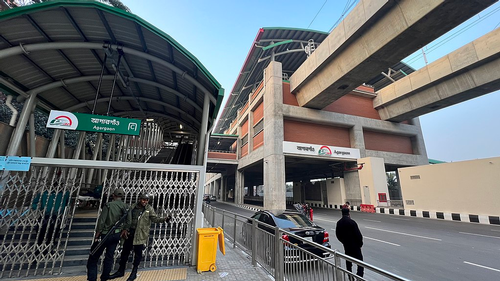WEDNESDAY, SEPTEMBER 27, 2023
Bangladesh’s government infrastructure megaprojects have reportedly contributed “significantly” to a recent surge in paint demand in the country, emphasizing the importance of paint production and variety.
According to an article from The Business Standard, around 240,000 liters (about 63,401 gallons) of industrial paint have reportedly been applied to steel structures and roofs of 16 new stations along Bangladesh’s first metro rail line, which is awaiting its full-service inauguration from Uttara to Motijheel.
Additionally, more than Tk25 crore (over $2 million) worth of decorative paint has been used throughout the metro rail project, including station embellishments, 24 sets of six-coach trains and depot work.
The specific paints, reportedly customized with Japanese technology, are said to have a market value exceeding Tk10 crore.
Paint Usage Findings
According to the report, significant structures, like the four coaling towers at the Rooppur nuclear power plant, have used industrial paint worth no less than Tk20 crore. The report states that this figure is expected to grow when considering decorative paint usage.

 |
| Dead.rabbit, CC-BY-SA 4.0, via Wikimedia Commons |
|
Bangladesh’s government infrastructure megaprojects have reportedly contributed significantly to a recent surge in paint demand, in turn encouraging entrepreneurs to emphasize the production of novel paint varieties. |
In this time, around Tk10 crore worth of paint is expected to be used for the third terminal of the Hazrat Shahjalal International Airport, planned for inauguration in October of 2023.
Government infrastructure megaprojects have also reportedly contributed to the growth in paint demand recently. The new expansion has reportedly led to increased employment opportunities in the country and a partial alleviation of pressure on the currency exchange rate due to reduced import dependence.
Manufacturers have stated that the industrial sector accounts for about 10-12% of the nation's total paint consumption, with at least half being directed toward government infrastructure.
Nurul Karim Sifat, head of marketing at Kansai Nerolac Bangladesh, stated that water-based paint is reportedly normally used for residential walls, as it can be easily mixed with water. However, such decorative paints have lower durability. In contrast, high-performance paints are used in industrial and large-scale infrastructures, which would require solvents to be mixed with oil-based paints.
Sifat explained the importance of long-lasting industrial paint in safeguarding installations from various risks, including sun and rain exposure.
Sifat also referenced the Dhaka Mass Transit Company Limited's request for a special type of paint with a 10-year guarantee for metro rail station steel structures. To meet this demand, new paint varieties were reportedly developed and supplied using Japanese technology.
The report adds that Kansai Nerolac has also created specialized technology paint for the coaling tower of the Rooppur Nuclear Power Plant, reasoning that large structure painting necessitates custom colors to enhance durability, necessitating lengthy research and approvals at multiple different stages.
Rajesh Sircar, deputy general manager of Nippon Paint, stated that around Tk10 crore worth of paint would be required for the installation. The cost, however, is reportedly comparatively lower compared to the installation size as decorative paints are mainly being used here.
Sircar stated that he believes that government infrastructure, particularly mega projects, plays a major role in the growth of the industrial paint industry.
He also added that domestic companies previously depended mainly on decorative paint for home use, resulting in import dependence as only one company produced industrial paints. The significance of industrial paint production has surged in the last eight to 10 years as the government prioritized megaproject implementation.
Now, around half a dozen multinational and domestic companies are reportedly able to supply multiple types of industrial paint, potentially leading to reduced prices and savings in foreign exchange due to a reduction in import reliance.
Sifat added that because various companies have attached importance to the industrial paint segment, investment, production and employment have reportedly increased. The surge in activity, the report states, has led to a two-fold benefit in the form of a decrease in the cost of paint and in foreign exchange expenditure due to decreased import dependency.
According to the report, government projects in the power sector are major consumers of paint, using large quantities. As an example, the report mentions that the rehabilitation project for Rohingyas on Bhashanchar Island has used about Tk7 crore worth of paint. Similarly, the Padma Rail Link project has reportedly involved the use of paints valued between Tk1.5 crore and Tk2 crore.
According to the country's Roads and Highways Department (RHD) sources, road marking has become a huge user of industrial paint in the construction and renovation of road infrastructure.
Around 60% of the total allocation for road marking is reportedly spent on buying paints on condition of anonymity. The remaining 40% is reportedly spent on thinner, labor wages, and machine maintenance, an official added.
An RHD additional chief engineer also told The Business Standard that there is no set amount of money per kilometer for road marking. The marking cost per kilometer has reportedly depended on road design, number of lanes, alignment and location.
The official added that he thinks that the cost of marking per kilometer on a four-lane road may be Tk7 lakh ($6350.19) to Tk10 lakh ($1,000,000).
The report adds that the implementation of about 125 projects in road construction under the RHD is going on at present. Even if Tk3 crore is spent on each project on an average, a total of Tk375 crore (over $340 million) will be spent in this sector in the next few years.
Tagged categories: Coating Application; Coating Materials; Coating Materials; Coating types; Coatings; Coatings Technology; Funding; Health and safety; Infrastructure; Infrastructure; Program/Project Management; Rail; Railcars; Transportation